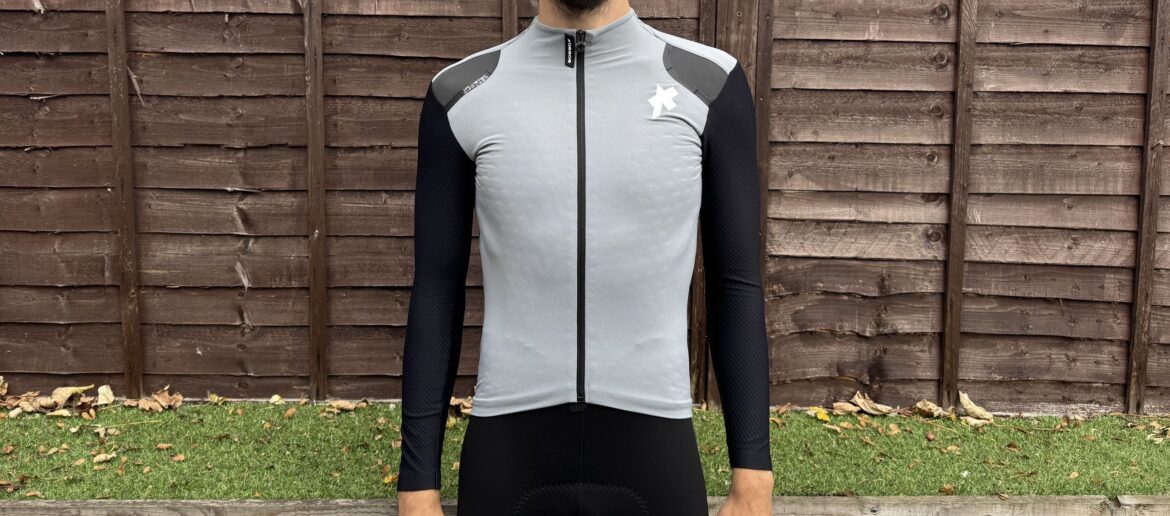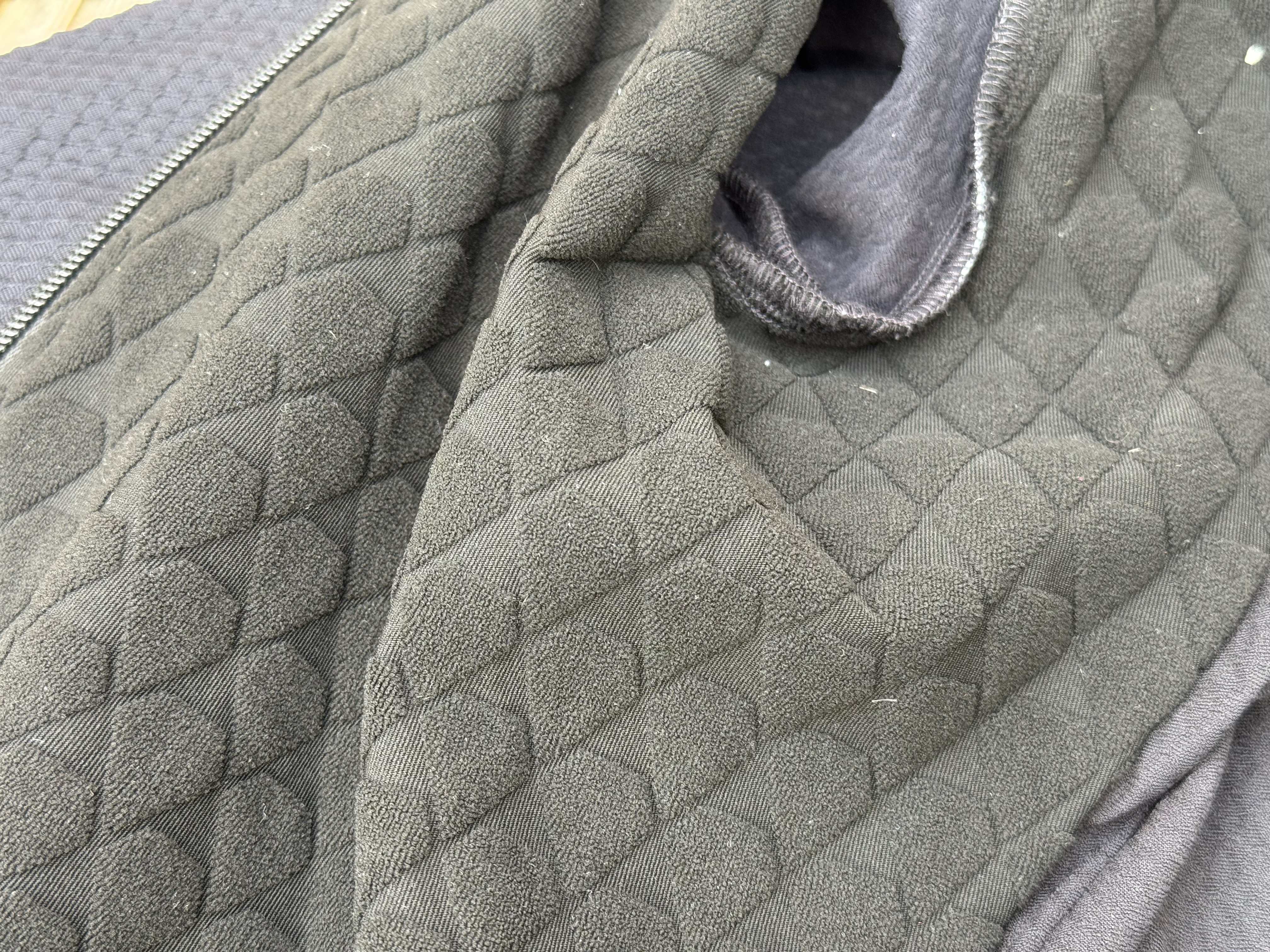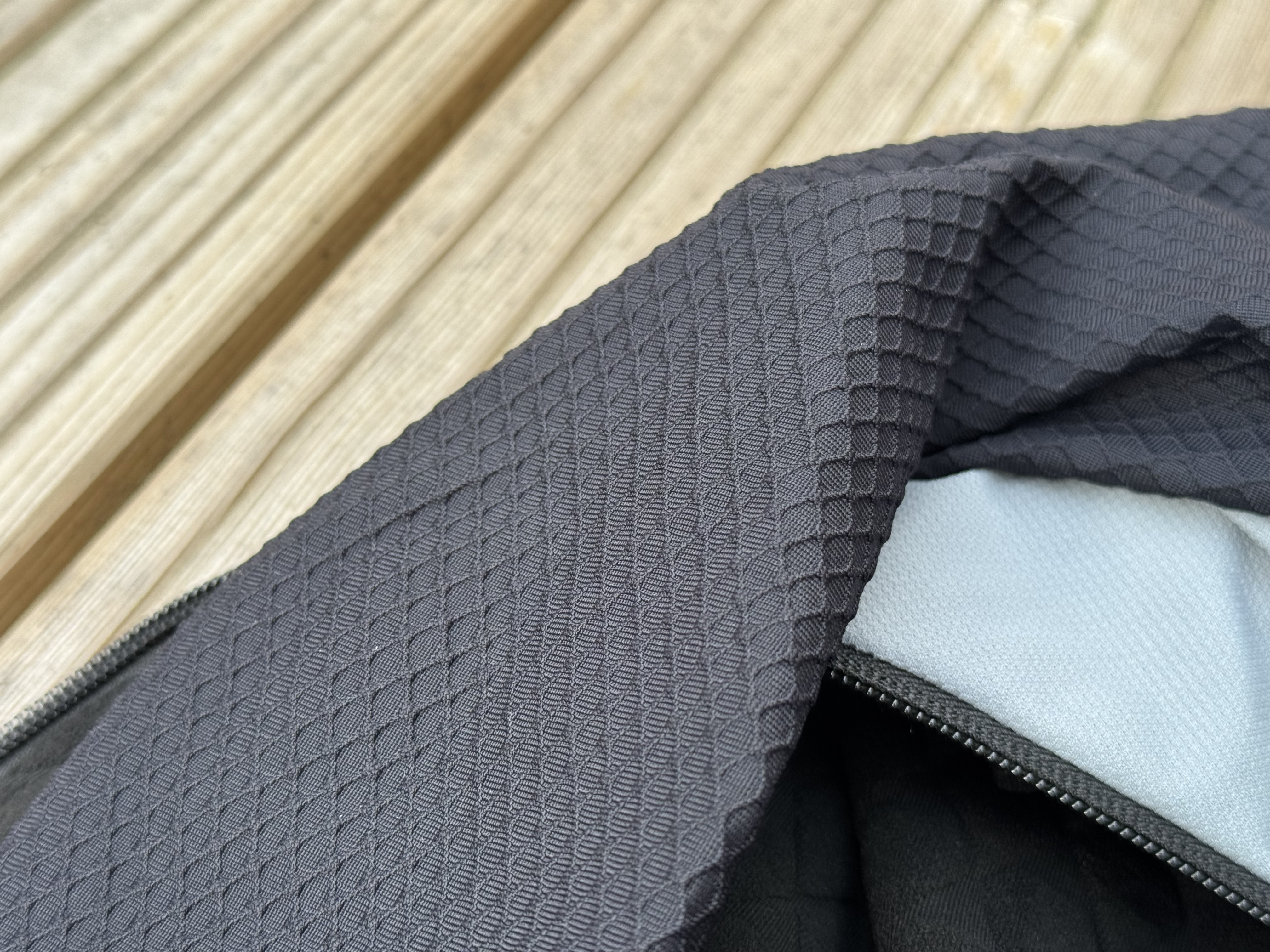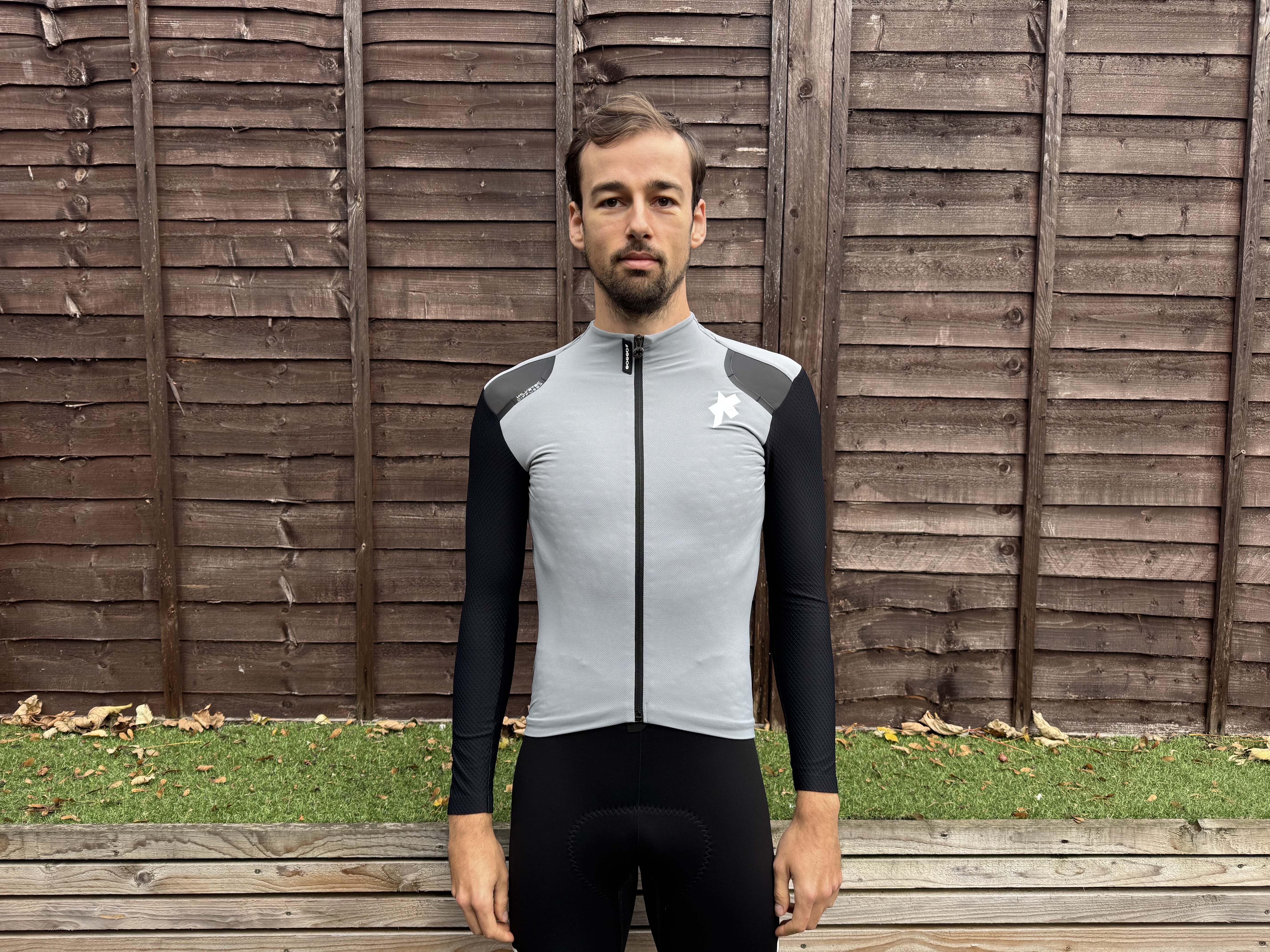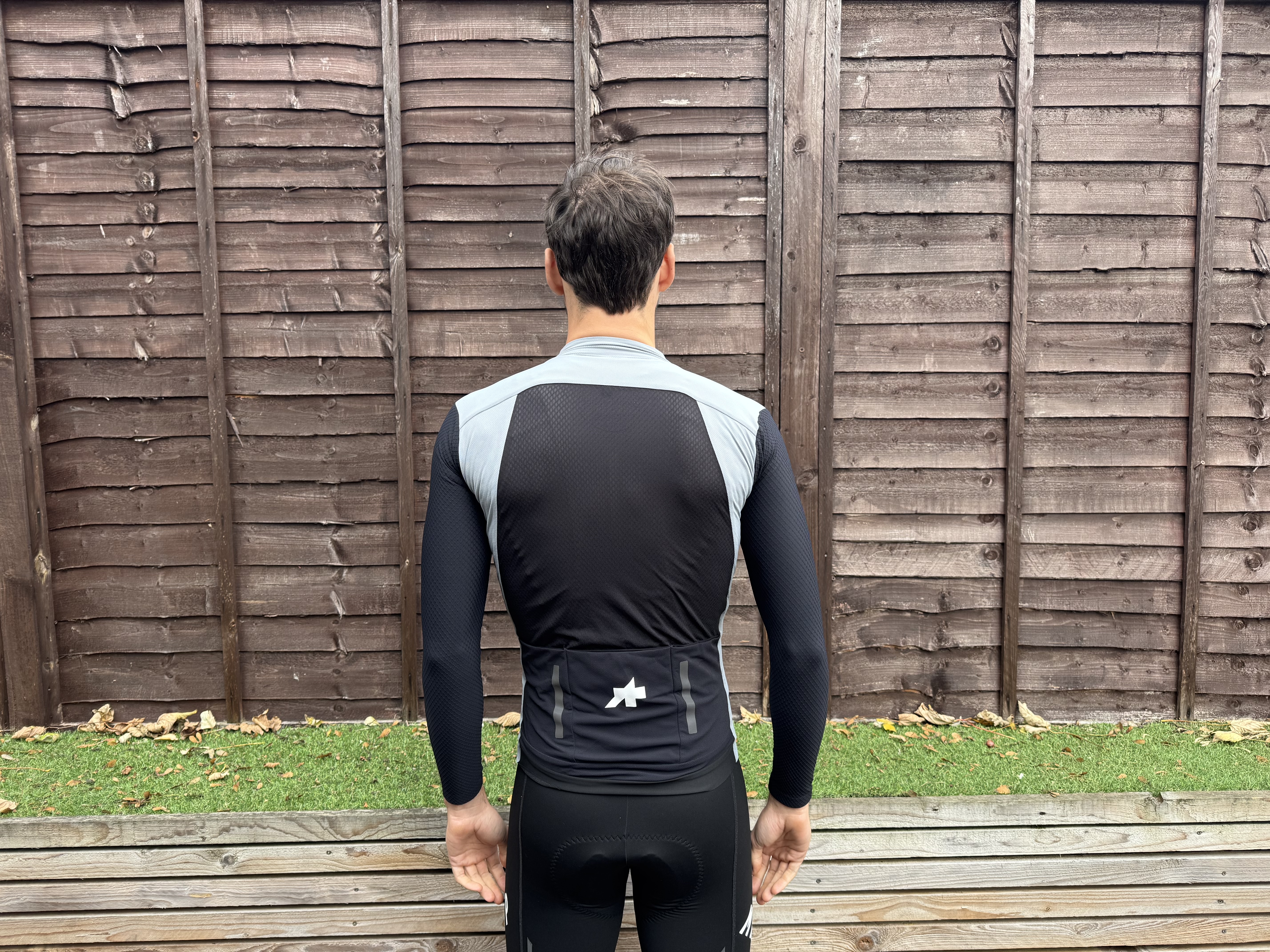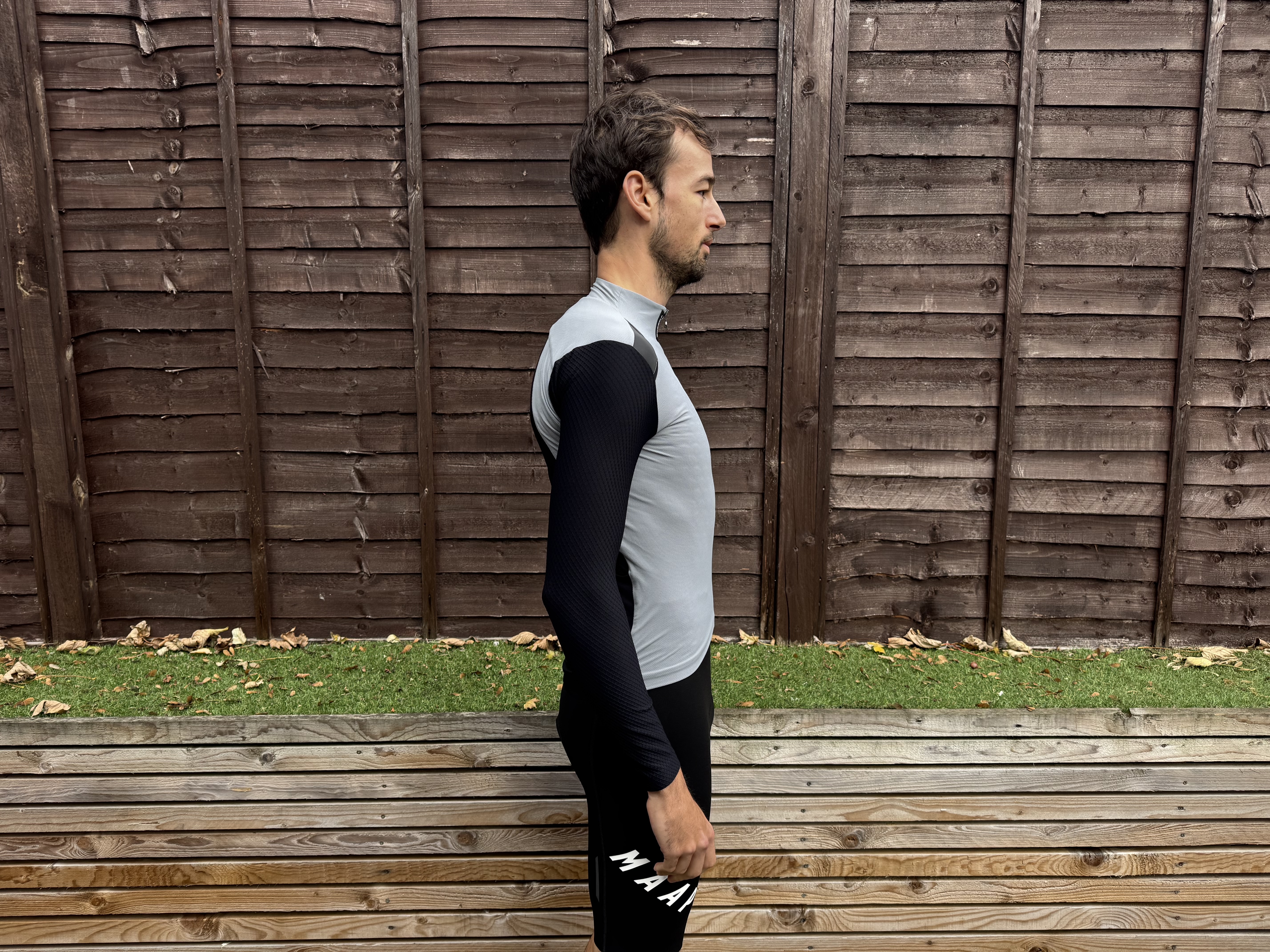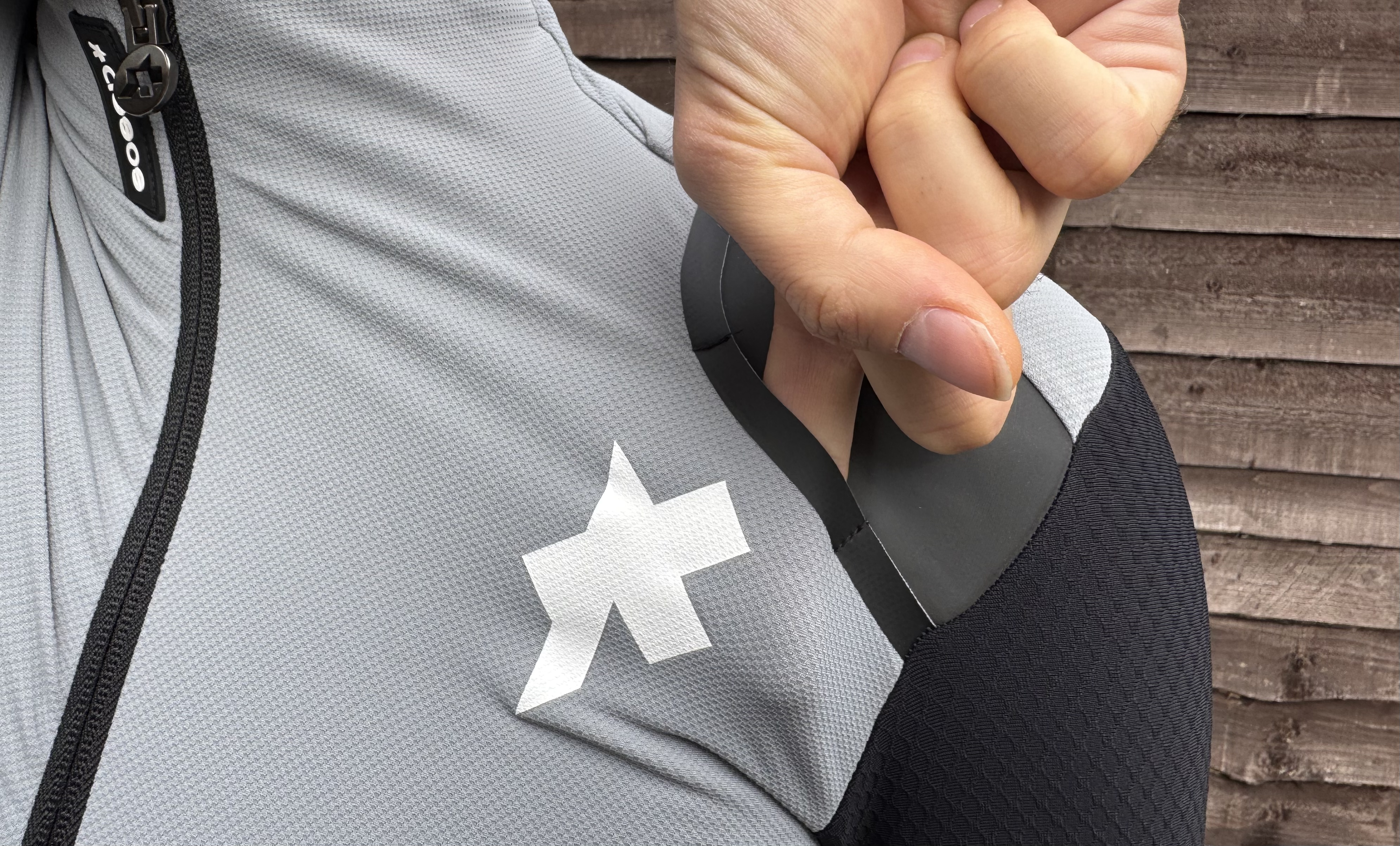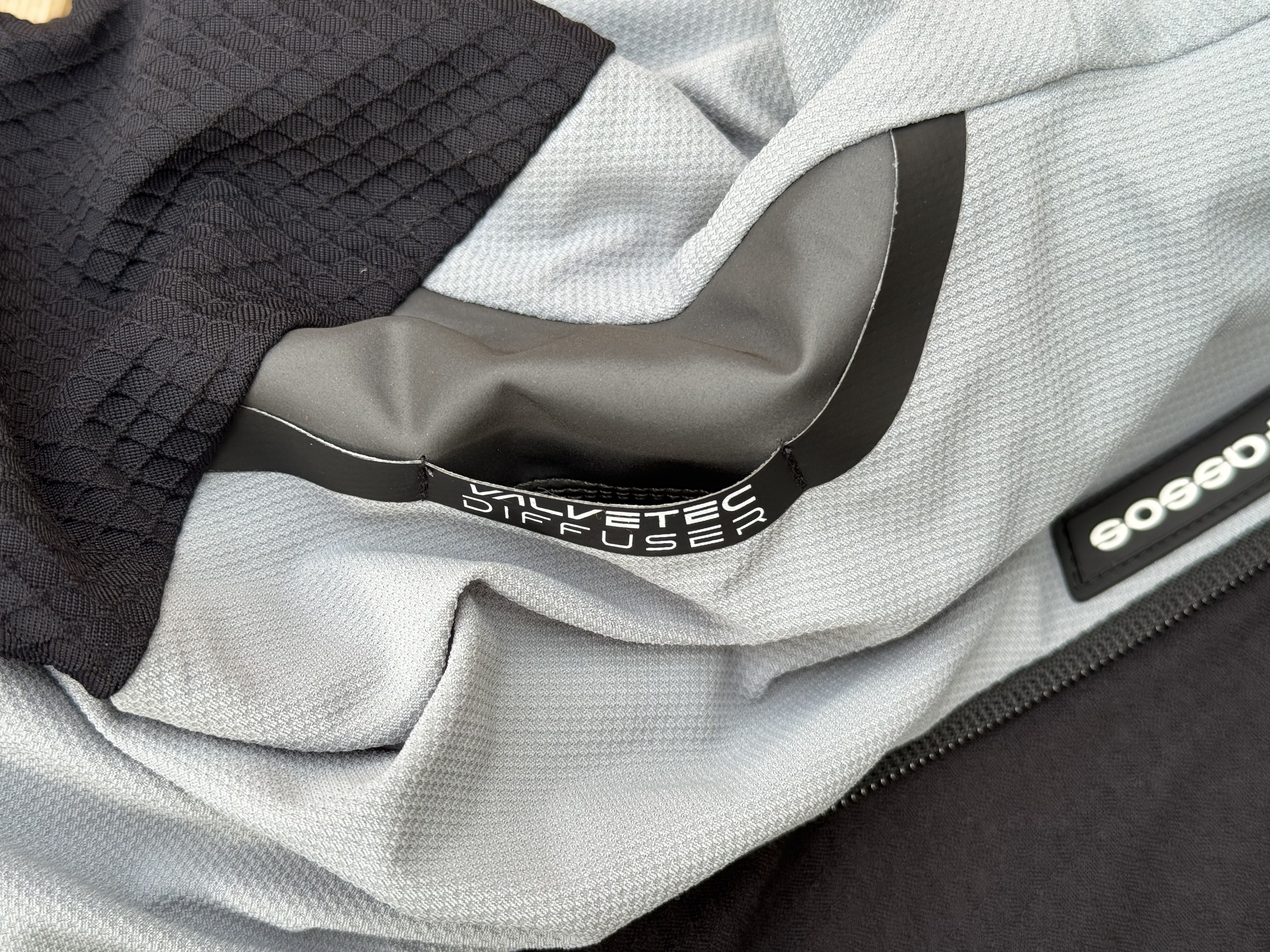Assos describes this jacket as the ultimate shoulder-season racing jacket, those months of September-October and March-April generally. Warmth and breathability have both been enhanced, while weight is dropped and the fit is more aggressive, something we see in several of the best winter cycling jackets. The Equipe RS is made up of a heap of different proprietary fabrics and technologies with names ranging from sensible to rather outlandish.
Construction
The ADAMANT inner layer features many small diamond shield shaped protrusions which allow for a degree of airflow internally. It’s a lighter version of the new DIAMOND Medium fabric used in the Johdah Ultraz line. It’s constructed in what’s called twinDeck, essentially meaning two separate layers for the internal and external materials so there is air between them.
On the sleeves, VIPER fabric is used. This is lighter, and features a diamond pattern designed to improve aerodynamics while being lightweight on insulation and heavy on breathability. The cuffs, and indeed all hems, are turned and stitched to provide a soft and seamless look. In pursuit of this breathable insulation, the rear central panel of the jacket is actually fully meshed and see-through. This is with the view that as we cycle we experience the elements face on, so the rear can be more open to allow for excess heat to escape without compromising insulation, especially at speed.
Further insulation enhancements are the valveTec diffusors: two small inlets on the shoulders that only let cool air in once you take a very aggressive head down position on the bike. Otherwise they allow for a small amount of excess heat to escape. These diffusors are also reflective with two additional reflective stripes on the rear pockets; the pockets use STABILIZATOR V11, a combination of fabric fit and structure designed to reduce the amount of ‘bounce’ that can be experienced when riding out of the saddle with full pockets.
This is all nicely contained in what Assos calls the AEPD 11 fit. It is the World Tour fit the company uses to envelop the body in 360˚ compression and stability, keeping everything in place essentially. Sizes range from XS to 2XL, while just this grey and black colourway are available.
The ride
I’m a fan of Assos’ modular approach, with its array of different panels all with a different area of focus. It’s vastly different to some kit manufactures who tend to apply a single fabric type across the entirety of the garment, rather than specific materials for specific regions. This latest S11, moving up from S9 and skipping 10 as is the Equipe naming convention, improves the aesthetics though, as the panels blend more seamlessly into each other rather than looking a little bit like a patchwork jacket.
Testing this jacket across the autumn months, it certainly abides by the design brief, being ideal for fast paced rides in cooler weather, while providing enough breathability for changing conditions. Using two separate layers at the front makes it incredibly comfortable and well insulated for conditions that dip below 10˚C. A layer of air between the two acts as an additional insulator even with a relatively thin material on both ends, while the outer provides a good level of windproofing across your core area. The sleeves don’t have the same insulation properties, but frankly they don’t need to, and I never had any issues of getting cold from about 8˚C upwards.
However, this is a dry-weather jacket. There is no water repellence on the outer layer, and although the two layers on the body do mean even when wet there is decent insulation, the sleeves do get cold as the thinner fabric does not stop the enhanced windchill effect on wet material. This is becoming more of a common trend though in transitional season jackets designed for higher paced riding. The reason being, a high focus on breathability, an area in which this jacket excels.
The mesh panel at the rear is quite extensive, exposing much of the back and allowing for an immense amount of excess heat to escape. As stated, this is a race-pace jacket, so even though the mesh means when stopping you cool down quickly, it’s not a jacket designed for stop-start riding or going casually in cooler weather. Adding to this breathability further are the diffuser valves. These are somewhat hit and miss as they only accept airflow once you are fully hunched over on the bike. Back in my racing days this would be a regular occurrence, less so now frankly as my stems are not slammed like they once were. I also personally like the lighter material on the sleeves for breathability purposes, and in the weather this jacket is designed for, it is a good compromise.
The lack of a two-way zip generally is something that I bemoan in jackets like this. They increase versatility and offer a way to increase hot air exhausted out the rear while limiting the amount the material can ‘flap about’. But again, this is a race garment, and unzipping from the top or the bottom has a varying impact on speed and aerodynamics. So good is the breathability at the rear that I did not find the need to unzip the jacket at all, save for some double digit gradient climbs, at which point I was going so slow that aerodynamic gains seemed limited. Combined with the race fit, the lack of two-way zip seems to make sense in this scenario, even if I prefer it for the ventilation options is allows. What does baffle me however is the fact the previous edition of this jacket did feature a two-way zip, so although I don’t necessarily miss the absence, it seems odd not to carry this feature over.
That race fit works a dream. Whether I was hunched over getting low to the bars, or sitting more upright, the jacket never bunched or pulled and allowed for a wide range of fit options. Some more race focussed garments can almost pull you into a race position, but the Equipe RS doesn’t force you to choose, instead adapting to where you want to be. It’s far more comfortable than some options I have experienced, including some Assos Equipe jackets of old.
The pockets are large and accommodate a heap of items. The STABILIZATOR V11, a silly name, admittedly does just what it sets out to do and stabilises the rear of the jacket so there are no sensations of pocket contents jumping around when bobbing out of the saddle. As always, I like a zip-up valuables pocket for keys or cards; it’s ideal and prevents them coming out in the event of tugging a packed up waterproof out of a pocket with smaller contents in tow. But this is a minor gripe.
Something I really appreciate are the sleeves, or rather the texturing specifically. I can’t say how aerodynamic this will be or at what speeds it will perform best. But a general rule of thumb is that a sleeve with texture will be faster than a smooth sleeve. This is due to reducing the turbulence behind the arm, and is a similar principle to why we see World Tour riders wearing kit with ridges on the sleeves. It’s both functional and performance focussed, which is exactly what this jacket should be. Interestingly the previous version of this jacket used more traditional aero fabric texturing, but sacrificed a bit of insulation for that purpose. I think for the temperatures this jacket is designed for, it’s a good overall decision to beef up the insulation while maintaining some form of texturing.
Value & conclusion
The closest competitor to the Equipe RS S11 is probably the Castelli Do.Di.Ci. Both are designed for the Autumn or Spring conditions, and both are designed for fast paced riding conditions where speed and breathability are key. Castelli undercuts Assos significantly here at £250 /$280, with the same single-way zip, cargo pockets, long sleeved, and focussing very highly on ventilation.
Where the two differ is that Castelli uses a single material for the whole jacket, the very breathable and fast drying Ristretto fabric. Meanwhile Assos uses a huge range of materials with different purposes. The Do.Di.Ci. is actually faster drying when it gets wet, which is useful, but is not designed for as cool a temperature as the Equipe RS. Additionally the Equipe RS is for a slightly cooler temperature range. Where the Assos jacket wins big is the sleeve texturing, which was my main gripe with the Do.Di.Ci. not using any aero materials on there.
While £305 / $390 is a lot of money, given the wide use of different materials, greater research and development costs to make these, and higher manufacturing costs to create the garments, that somewhat explains the higher price. Of course there are better value options, indeed the Assos Equipe RS S11 jersey is cheaper and features many similarities, but just not quite the same level of performance focus and less insulation.
For actual race pace rides, it’s actually hard to find fault with this jacket. Zero water proofing does mean it’s a dry weather garment only, and breathability means in cold weather you will not want to stop riding for fear of cooling down a lot. However, it is designed for fast paced riding and speed performance. In those regards, it performs brilliantly. But there’s also an element of how often will you need that. In the UK road race season for example, I can see this being good for early season events from January to March, but outside of that and above 15˚C it would be too warm. Local fast paced group rides also don’t run until the clocks change and the weather becomes more of a short sleeve affair.
It’s a great jacket for what it does, but for most of us this might be a somewhat limited window. We’re not World Tour pros racing in European wind and rain spending hours in the bunch with single figure body fat percentages where insulation in races is very important. That still won’t stop me from wearing this on cooler solo jaunts just for the sake of hopefully having an increased average speed compared potentially to other jackets though.
The Assos Equipe RS Spring Fall Jacket S11 has been designed as a race pace jacket that prioritises breathability and performance, while providing impressively good levels of insulation alongside this. Aero textures sleeves are a performance highlight, as is the highly breathable rear of the jacket. Fit is also exceptional, but there is a distinct lack of water resistance, limiting the effective use somewhat. It is brilliant as a cool weather fast paced riding jacket, but it is a slightly niche market. Being usable in warmer conditions might enhance true versatility, or being a bit water resistant. It’s also not cheap at £305 /$390, but is a brilliant amalgamation of clever technologies and fabrics that make for a jacket that is great as what it has been designed to do.
